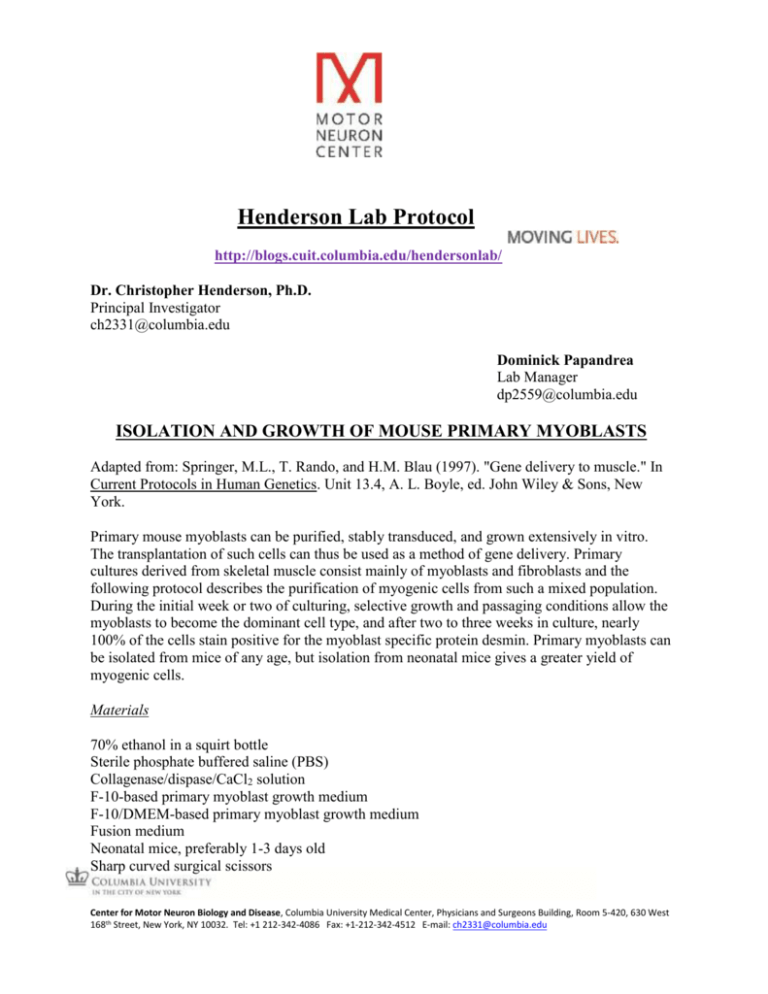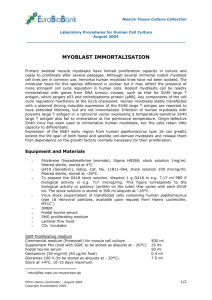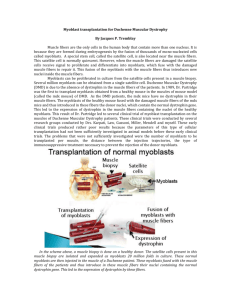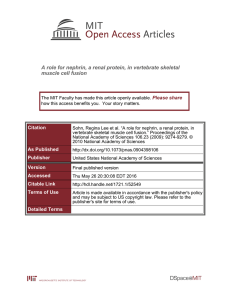Isolation and growth of mouse primary myoblasts
advertisement

Henderson Lab Protocol http://blogs.cuit.columbia.edu/hendersonlab/ Dr. Christopher Henderson, Ph.D. Principal Investigator ch2331@columbia.edu Dominick Papandrea Lab Manager dp2559@columbia.edu ISOLATION AND GROWTH OF MOUSE PRIMARY MYOBLASTS Adapted from: Springer, M.L., T. Rando, and H.M. Blau (1997). "Gene delivery to muscle." In Current Protocols in Human Genetics. Unit 13.4, A. L. Boyle, ed. John Wiley & Sons, New York. Primary mouse myoblasts can be purified, stably transduced, and grown extensively in vitro. The transplantation of such cells can thus be used as a method of gene delivery. Primary cultures derived from skeletal muscle consist mainly of myoblasts and fibroblasts and the following protocol describes the purification of myogenic cells from such a mixed population. During the initial week or two of culturing, selective growth and passaging conditions allow the myoblasts to become the dominant cell type, and after two to three weeks in culture, nearly 100% of the cells stain positive for the myoblast specific protein desmin. Primary myoblasts can be isolated from mice of any age, but isolation from neonatal mice gives a greater yield of myogenic cells. Materials 70% ethanol in a squirt bottle Sterile phosphate buffered saline (PBS) Collagenase/dispase/CaCl2 solution F-10-based primary myoblast growth medium F-10/DMEM-based primary myoblast growth medium Fusion medium Neonatal mice, preferably 1-3 days old Sharp curved surgical scissors Center for Motor Neuron Biology and Disease, Columbia University Medical Center, Physicians and Surgeons Building, Room 5-420, 630 West 168th Street, New York, NY 10032. Tel: +1 212-342-4086 Fax: +1-212-342-4512 E-mail: ch2331@columbia.edu 2 pairs of fine forceps Low power stereo dissecting microscope Sterile razor blade 80 m nylon mesh (e.g. Nitex; Tetko, Inc.; Monterey Park, CA) Small sterile funnel Collagen-coated tissue culture dishes: 35 mm, 60 mm, 100 mm, and 150 mm sizes Humidified 37°C, 5% CO2 incubator Inverted microscope Isolate limb muscle 1. Sacrifice 1-5 neonatal mice by decapitation or CO2 inhalation. 2. Rinse the limbs with 70% ethanol and remove them with sterile scissors. Dissect the muscle away from the skin and bone with sterile forceps. Dissection is easier if done under a stereo dissecting microscope. Store the muscle tissue in a culture dish on ice in a drop of sterile PBS as successive limbs are being processed, maintaining sterility in the accumulated tissue. Dissociate muscle cells 3. Add enough PBS to keep the tissue moist, and mince to a slurry with razor blades in the culture dish. Do this and all subsequent steps in a sterile tissue culture hood. 4. Add approximately 2 ml of collagenase/dispase/CaCl2 solution per gram of tissue and continue mincing for several minutes. For the amount of tissue obtained from 1-5 neonatal pups, 0.5 ml of the enzyme solution is usually sufficient. 5. Transfer the minced tissue to a sterile tube and incubate at 37°C until the mixture is a fine slurry, usually about 20 min. Several times during the incubation, gently triturate with a plastic pipette to break up clumps. 6. If desired, the slurry can be filtered through a piece of 80 µm nylon mesh in a sterile funnel to remove large pieces of tissue. 7. Centrifuge the cells for 5 min at 350 x g. Resuspend the pellet in 2-4 ml of F-10-based primary myoblast growth medium depending on the amount of tissue processed, and plate in a 35-60 mm collagen coated culture dish. It is common to see a great deal of debris and very few recognizable cells; however, after two days, many cells will be evident and the debris will be rinsed away during the first change of medium. Enrich for myoblasts 8. Incubate in a 37°C 5% CO2 incubator and change the medium every 2 days, using F-10based primary myoblast growth medium. Do not leave cells in the same culture dish for more than 5 days, regardless of cell density. Primary myoblasts grow best when dense. Do not grow them at less than approximately 10% confluence, but also do not allow them to become too crowded, or else they may start to differentiate or die. Split them at no more than 1:5 dilution. The F-10-based primary myoblast growth medium gives myoblasts a growth advantage over fibroblasts. 9. When the cells are ready to be split, remove the cells from the dish using PBS with no trypsin or EDTA. This is accomplished by aspirating off the growth medium, rinsing the dish with PBS, leaving a small amount of PBS in the dish, and hitting the dish very firmly in a sideways fashion against the edge of a table top to dislodge the cells. It can take several minutes of incubation in the PBS before the cells can be knocked off of the tissue culture plastic. However, the myoblasts will freely come off during this treatment and many fibroblasts will be left behind. 10. Preplate the cells for 15 min on a collagen coated dish before moving the cells remaining in suspension to a new collagen coated dish. This tends to leave behind cells that stick quickly, which are predominantly fibroblasts. To avoid leaving myoblasts behind, swirl the liquid in the dish, tilt it towards the pipette, and jostle the dish from side to side while slowly removing the cell suspension. Failure to do this can result in a significant number of myoblasts trapped in the meniscus. 11. Repeat steps 9 and 10 for the initial week of culture expansion or until most of the fibroblasts are gone from the culture. Fibroblasts tend to be very flat when grown on collagen, whereas myoblasts are more compact and much smaller in diameter. Myoblasts can also be identified by immunofluorescent staining for desmin. 12. After the fibroblasts are no longer visible in the culture, the medium can be changed to F-10/DMEM-based primary myoblast growth medium. This medium allows myoblasts to grow faster and to higher densities. However, it also removes the selective growth advantage of myoblasts over fibroblasts, and thus should not be used until after the fibroblasts are gone. This medium can be changed every three days instead of every two, but care should still be taken to avoid overgrowth of cells. Primary myoblasts can be frozen for storage using standard cell culture protocols. After approximately one week of growth, the myoblasts usually go through a crisis period during which a significant fraction of the population (sometimes the majority) dies. This tends to occur at the time that the fibroblasts have disappeared from the culture, although a direct correlation has not been confirmed in our laboratory. The remaining myoblasts soon repopulate and have a remarkable proliferative ability (up to 100 doublings) but still retain the ability to differentiate under the proper conditions. Confirm ability to differentiate in culture 13. If desired, the potential of the myoblasts to differentiate in culture can be assessed by replacing the medium with fusion medium. The medium must be changed daily. Start with an approximately 30-50% confluent dish of cells. Within several days to one week, large multinucleated myotubes should be quite obvious. After approximately one week in fusion medium, the myotubes can sometimes be observed to twitch randomly as the contractile machinery assembles. REAGENTS AND SOLUTIONS Collagen-coated tissue culture dishes Add 1 ml concentrated acetic acid to 179 ml H2O Sterile filter through 0.2 µm filtration unit Add 20 ml 0.1% calf skin collagen in 0.1 N acetic acid (Sigma) Incubate in plastic tissue culture dishes overnight at room temperature Remove collagen solution (can be reused; store at 4oC) Rinse dishes well with sterile H2O; allow to dry Store at room temperature for at least 6 months Collagenase/dispase/CaCl2 solution 1.5 U/ml collagenase D (Boehringer Mannheim Corp.) from -20oC frozen aliquot 2.4 U/ml dispase II (Boehringer Mannheim Corp.) from -20oC frozen aliquot 2.5 mM CaCl2 Use immediately. F-10-based primary myoblast growth medium 400 ml Hams F-10 nutrient mixture (GIBCO BRL) 100 ml fetal calf serum (HyClone Laboratories, Inc.) (20% final) 50 µl of 25 µg/ml basic fibroblast growth factor (human; Promega Corp.) in 0.5% bovine serum albumin/PBS; freeze aliquots only once at -20oC (2.5 ng/ml final) 5 ml 100x penicillin/streptomycin (GIBCO BRL; final concentration is 100 U/ml and 100 µg/ml, respectively) Store at 4oC for at least 1 month F-10/DMEM-based primary myoblast growth medium Same as above but use 200 ml F-10 and 200 ml Dulbeccos Modified Eagle Medium (DMEM; GIBCO BRL) in place of the 400 ml F-10 Fusion medium 95 ml DMEM 5 ml horse serum (HyClone) (5% final) 1 ml 100x penicillin/streptomycin solution (above) Store at 4oC for at least 1 month Phosphate buffered saline (PBS), 10x stock 2.0 g KCl 2.0 g KH2PO4 80.0 g NaCl 11.4 g Na2HPO4 (anhydrous) Dissolve Na2HPO4 in 200 ml ddH2O with stirring and heating Dissolve remaining three salts in 700 ml ddH2O; combine both solutions Adjust pH to 7.4 with 5N NaOH Adjust volume to 1 liter and autoclave or filter. Store at room temperature. Updated 8/2002





